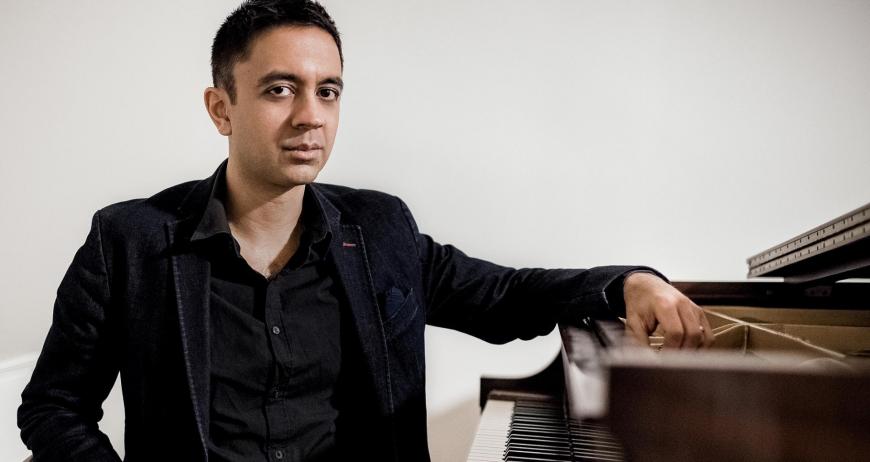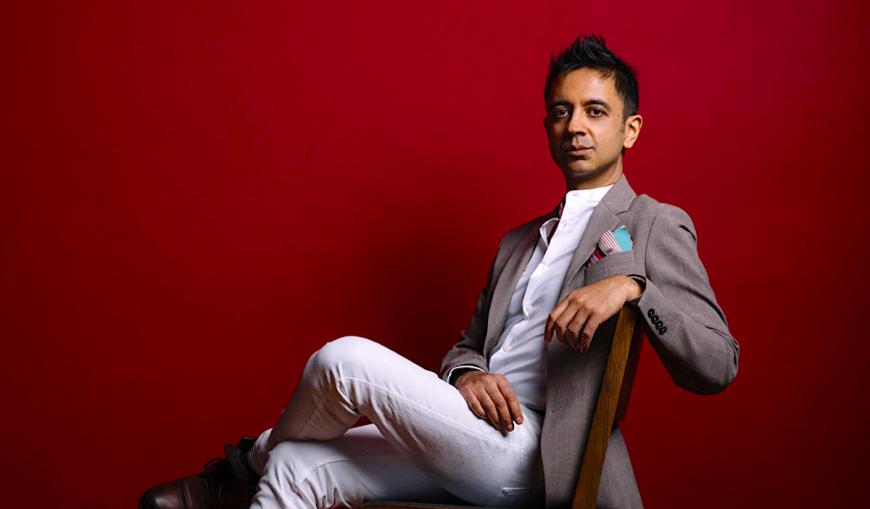
When Vijay Iyer arrived at UC Berkeley in the summer of 1992 to start a graduate degree in physics his commitment to the program was more dutiful than heartfelt. Harboring a deep infatuation for jazz, he nonetheless hoped he would “learn how to love physics, which is not a great place to enter a Ph.D. program,” he said.
Once the pianist started connecting with singular Bay Area improvisers like tenor saxophonists Hafez Modirzadeh and Francis Wong, he found himself in something of a crisis. An apprenticeship with jazz conceptualist Steve Coleman that led to a European tour and four pivotal albums with the altoist’s band Five Elements convinced Iyer that he wanted to explore the protean nature of rhythmic pulses rather than atomic structures, and he found a way to change course after finishing his coursework.
Rather than drop out of Cal, Iyer ditched the physics department for the Center for New Music and Audio Technologies (CNMAT), a multidisciplinary research center run by electronic music pioneer David Wessel. Working with Wessel and trombonist/composer George Lewis, a brilliant experimentalist on faculty at Mills College, Iyer designed his own doctoral program, leading to his 1998 thesis “Microstructures of Feel, Macrostructures of Sound: Embodied Cognition in West African and African-American Musics.”
Since releasing his 1995 debut album Memorophilia, on San Francisco-based AsianImprov, Iyer has emerged as an era-defining jazz artist. He’s earned numerous commissions and awards, including a 2013 MacArthur “Genius” Fellowship and the Alpert Award in the Arts. In the end, he made peace with academia, taking on the Franklin D. and Florence Rosenblatt Professor of the Arts endowed chair at Harvard University, where he’s continued to expand an extraordinary array of collaborations as player and composer in jazz, classical, and new-music settings. While often pegged as a player more engaged with heady concepts than visceral passion, Iyer is a deeply expressive musician fully capable of exploring subtle emotional shades. These recordings serve as a wide-angle introduction to his music.

Vijay Iyer and Rudresh Mahanthappa Raw Materials (Savoy) 2006
Iyer and alto saxophonist Rudresh Mahanthappa have collaborated on various projects since the late 1990s, and this mercurial duo session is one of their most spacious and intimate recordings. Both players contributed compositions, and rather than stretching out they get to the point, quickly setting a mood, sketching a scene, or conjuring a scenario. The majority of the tracks are considerably shorter than 4:30, and Iyer seems to anticipate where his comrade in improvisation wants to go.
Vijay Iyer Solo (ACT Music) 2010
With a program calculated to show history in motion, Iyer’s first solo recording is a consistently fascinating, occasionally maddening project. Opening with his deconstruction of the Michael Jackson hit “Human Nature,” the album includes a careful dissection of Monk’s harmonically ambiguous “Epistrophy” to an unsettling reading of “Darn That Dream” and a bent but reverent examination of Ellington’s “Black and Tan Fantasy.”
Vijay Iyer and Wadada Leo Smith A Cosmic Rhythm With Each Stroke (ECM) 2016
After working extensively in Wadada Leo Smith’s Golden Quartet, Iyer meets the great trumpeter and jazz explorer on equal terms on this duo project. The album’s centerpiece is a seven-movement suite dedicated to the great Indian visual artist Nasreen Mohamedi, and the music often evokes the hypnotic pulse of her beautifully calibrated lines generous use of space. The palette is austere and the pieces defined by portentous stretches of silence with Iyer adding quavering electronic textures on some of the more atmospheric pieces, though both players find opportunities for quick melodic feints.
Vijay Iyer Sextet Far From Over (ECM) 2017
On most days this is my favorite Iyer album so far, a consistently combustible session bristling with divergent musical personalities. In the front line, the dry-toned altoist Steve Lehman and fiery cornetist Graham Haynes, who also supplies some buzzy textures on electronics, provide fricative contrasts, while the explosive drummer Tyshawn Sorey pushes against Stephan Crump, a bassist with a penetrating tone and rock-solid architectural sense of form. Iyer’s percussive piano work surges, leaps, and pivots, defining his angular lines and densely lapidary textures. The wild card is burly, thick-toned tenor saxophonist Mark Shim, a tremendously resourceful improvisor who should be mentioned more often as one the most distinctive players of his generation. If Iyer’s tunes aren’t especially memorable, he is an expert at setting his collaborators in motion and supplying them with puzzles that keep everyone on their toes.
Vijay Iyer Trio Accelerando (ACT Music) 2012
Probably the best album to get a sense of Iyer’s priorities as a pianist, Accelerando features his celebrated, long-running trio with drum master Marcus Gilmore and bassist Stephan Crump, one of Iyer’s key collaborators. The program balances Iyer’s originals with an expansive array of material, from Ellington’s rarely played “The Village of the Virgins” (from The River Suite) and Herbie Nichols’ loping “Wildflower” to an undressed take on Rod Templeton’s “The Star of the Story” and the wicked, cinematic funk of the Thundercat/Flying Lotus joint “Mmmhmm.” Skittery and polished, raw and cerebral, the trio makes contrasting impulses sound like kissing cousins.




